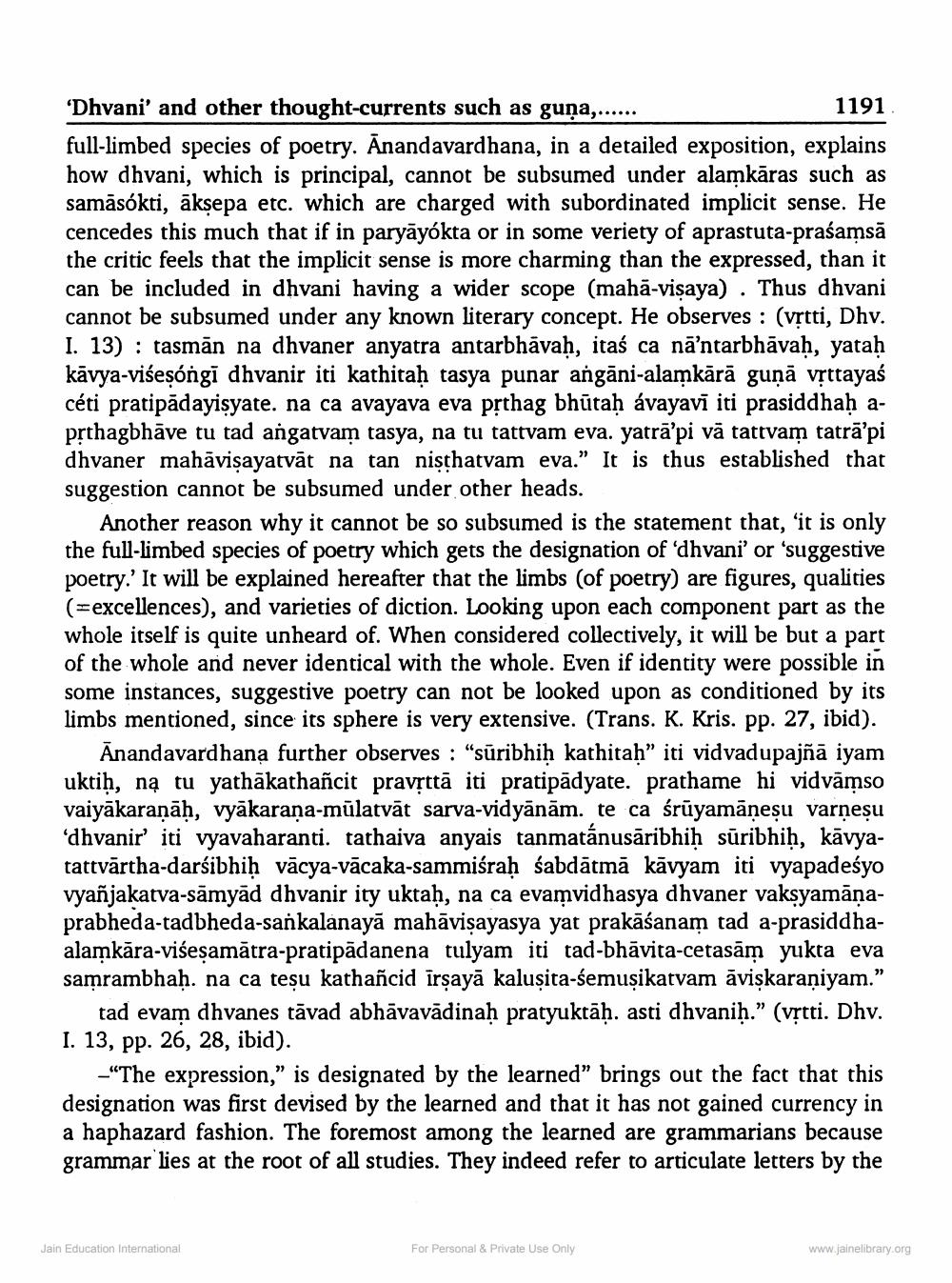________________
'Dhvani' and other thought-currents such as guna,......
1191. full-limbed species of poetry. Anandavardhana, in a detailed exposition, explains how dhvani, which is principal, cannot be subsumed under alamkāras such as samāsókti, āksepa etc. which are charged with subordinated implicit sense. He cencedes this much that if in paryāyókta or in some veriety of aprastuta-praśamsā the critic feels that the implicit sense is more charming than the expressed, than it can be included in dhvani having a wider scope (mahā-visaya) . Thus dhvani cannot be subsumed under any known literary concept. He observes : (vľtti, Dhv. I. 13) : tasmān na dhvaner anyatra antarbhāvah, itaś ca nā'ntarbhāvah, yatah kāvya-viśeşóngi dhvanir iti kathitaḥ tasya punar angāni-alamkārā guņā vsttayaś céti pratipādayisyate. na ca avayava eva prthag bhūtah ávayavī iti prasiddhaḥ a prthagbhāve tu tad angatvam tasya, na tu tattvam eva. yatrā'pi vā tattvam tatrā'pi dhvaner mahävisayatvāt na tan nisthatvam eva." It is thus established that suggestion cannot be subsumed under other heads.
Another reason why it cannot be so subsumed is the statement that, 'it is only the full-limbed species of poetry which gets the designation of 'dhvani' or 'suggestive poetry.' It will be explained hereafter that the limbs (of poetry) are figures, qualities (=excellences), and varieties of diction. Looking upon each component part as the whole itself is quite unheard of. When considered collectively, it will be but a part of the whole and never identical with the whole. Even if identity were possible in some instances, suggestive poetry can not be looked upon as conditioned by its limbs mentioned, since its sphere is very extensive. (Trans. K. Kris. pp. 27, ibid).
Anandavardhana further observes : "sūribhiḥ kathitaḥ” iti vidvadupajñā iyam uktih, na tu yathākathañcit pravsttā iti pratipădyate. prathame hi vidvāmso vaiyakaranāh, vyākarana-mülatvāt sarva-vidyānām. te ca śrūyamānesu varnesu dhvanir iti vyavaharanti. tathaiva anyais tanmatánusāribhiḥ sūribhiḥ, kāvyatattvārtha-darsibhiḥ vācya-vācaka-sammiśraḥ śabdātmā kāvyam iti vyapadesyo vyañjakarva-sāmyad dhvanir ity uktah, na ca evamvidhasya dhvaner vaksyamānaprabheda-tadbheda-sankalanayā mahāvisayasya yat prakāśanam tad a-prasiddhaalamkāra-visesamātra-pratipādanena tulyam iti tad-bhāvita-cetasām yukta eva samrambhah. na ca tesu kathañcid īrṣayā kaluşita-semușikatvam āviskaraniyam."
tad evam dhvanes tāvad abhāvavādinah pratyuktāḥ. asti dhvanih.” (vștti. Dhv. I. 13, pp. 26, 28, ibid).
-“The expression,” is designated by the learned" brings out the fact that this designation was first devised by the learned and that it has not gained currency in a haphazard fashion. The foremost among the learned are grammarians because grammar lies at the root of all studies. They indeed refer to articulate letters by the
Jain Education International
For Personal & Private Use Only
www.jainelibrary.org




